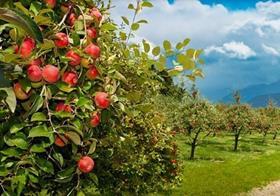
Pipfruit New Zealand (PNZ) says it expects this year’s New Zealand apple production to be about 20 per cent higher than in 2010 at around 17.5m 18kg tray carton equivalents (TCE).
Both Hawke’s Bay and Nelson, which supply over 90 per cent of the country’s apple export volume, enjoyed significantly better growing conditions than in the previous season, when rain and hail caused significant damage to the crop.
The increase in the crop has covered all of New Zealand’s major varieties, PNZ’s CEO Peter Beaven told Fruitnet.com, and brings the industry back to the kind of volume it was harvesting in the mid-2000s.
“The is potentially the second or third biggest crop we’ve produced,” Mr Beaven said. “We’re probably looking at around 17.5m cartons, and the increase is across the board, although there was a particular bounce back of the Braeburn crop.”
With picking of early varieties such as Pacific Beauty – also known as New Zealand Beauty – beginning this week and next, growers are pleased with the overall crop’s size profile, with Royal Gala averaging a 112 count and Braeburn peaking between count 100 and 110.
Production of club variety Jazz is continuing along the upward curve which placed it as the third most produced variety in New Zealand last season, slightly ahead of the similarly increasing volumes of Fuji.
“In Asia sales of the Pacific Series are all up as well,” said Mr Beaven. “We can’t grow enough of them for Asia…and there certainly has been an increase in plantings, particularly Pacific Queen `also known as New Zealand Queen`.
“Fuji is looking good, and we’ll see the first reasonable size crop of Envy. Although it’s still a small variety, there have been quite a few plantings over winter.”
Markets
Sales into Asia are looking optimistic this season, with a new marketing programme in India and a more relaxed SPS protocol for mainland China this year.
South East Asia is presenting some challenges this season, with the new 3P packaging requirement in Malaysia and new residue requirements in Indonesia, but the region as a whole is continuing to show steady growth and solid returns.
Mr Beaven added that PNZ was “cautiously optimistic” about the industry’s prospects this year in Europe.
This season’s smaller Braeburn size profile is expected to help New Zealand exports better fit market requirements that last season, and the variety will also benefit from a new industry-wide promotion in the European market.
In-market stock levels were at a similar level to the previous year, he noted, while a recent strengthening of the local currency in Brazil – traditionally the first Southern Hemisphere supplier to ship apples to Europe – was expected to lead to a decrease in the Latin American country’s early exports.
Chile is likely to face a similar currency-related challenge, Mr Beaven suggested. Chilean apple exports are estimated to rise by 2 per cent rise this year to 858,171 tonnes, compared with 841,827 tonnes in 2010, according to Decofrut.



